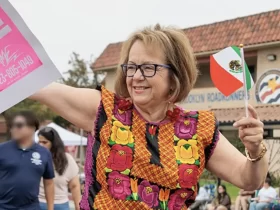In the 1980s, Mexican television experienced unprecedented growth, with telenovelas emerging as a cultural phenomenon ingrained in the lives of millions of viewers. During this period, captivating stories were produced that became classics that will endure over time and leave an indelible mark on the collective memory.
Among the best Mexican telenovelas of the 1980s are:
Cuna de Lobos (1986-1987): Directed by Carlos Tellez, it is considered one of the best in the history of Mexican television. The story starred María Rubio, Gonzalo Vega and Rebecca Jones and revolved around the Larios family, headed by the cunning and manipulative Catalina Creel (María Rubio). Catalina is an unscrupulous woman who is willing to do anything to maintain control over her family and protect her economic interests. The plot thickens with deceit, betrayal, murder and family secrets.
“Cuna de Lobos” was a huge ratings success in Mexico and in several Spanish-speaking countries. The telenovela stood out for its intricate plot, unexpected twists and the masterful performance of María Rubio as the villain Catalina Creel.
Quinceañera (1987-1988): It was a huge success and launched the careers of Thalia and Adela Noriega. “Quinceañera” centers on the lives of two friends, Maricruz Fernández (Adela Noriega) and Beatriz Villanueva (Thalía), who share the same birthday and celebrate their quinceañera together. The plot deals with themes such as love, friendship, family conflicts and the challenges of adolescence.
The song “Quinceañera”, performed by Thalia, was a hit in the telenovela and is still remembered as one of the most important songs of the singer’s career.
Rosa Salvaje (1987-1988): The plot focuses on Rosa García, played by Verónica Castro, a poor, naive and unconventional woman who has lived with her godmother ‘Tomasa’ (Magda Guzmán) since childhood. Despite lacking a formal education, Rosa responds to attacks by directly confronting those who victimize her, earning her the nickname “la salvaje” (the savage). The narrative focuses on her defiant struggle for survival as she becomes embroiled in a love story with Ricardo Linares, played by Guillermo Capetillo. However, their relationship faces significant obstacles due to the opposition of Ricardo’s wealthy family.
The chemistry between the protagonists and the romantic and emotional plot contributed to the telenovela’s appeal. Verónica Castro received accolades for her performance as Rosa, and the entrance song “Rosa Salvaje” also became very popular. The love story between Rosa and Ricardo continues to be remembered by generations of viewers.
El Maleficio (1983-1984): Follows the story of Beatriz, a widow with two kids, Vicky and Juanito. When she meets Enrique de Martino, a wealthy millionaire, she decides to marry him. However, she soon discovers that her husband is linked to a cult and that his wealth has roots in black magic. The plot dives into themes of witchcraft and the occult, featuring an elite cast including Ernesto Alonso, Humberto Zurita, Erika Buenfil, Sergio Goyri, Rebecca Jones and Eduardo Yáñez. Produced by Ernesto Alonso and directed by Raúl Araiza, “El Maleficio” not only stands out for its dark plot, but also for the persistent rumors of strange phenomena on the set, contributing to its reputation as a telenovela shrouded in mystery. With 320 episodes, this series remains a landmark in the suspense and magic genre, leaving a lasting impression on Mexican television.
El Pecado de Oyuki (1988): The plot revolves around Oyuki (Ana Martin), a young Japanese peasant girl growing up with her parents in a small country house in the province. She is innocent, beautiful and honest. The story focuses on Oyuki’s experiences, including the difficulties she faces after the death of her parents and her evil brother. The novela has become a landmark in Mexican television and is notable for the sacrifice of the health of its protagonist, Ana Martín, to play her character.
“Oyuki’s Sin” was well received by the public and its focus on a cross-cultural love story was groundbreaking for its time. It had a great impact and scored 92 points in the ratings, received several awards and was broadcast in Latin American countries, as well as being a great success in Japan.
It was the first (and probably the only) Mexican telenovela dubbed into Cebuano and Hiligeino for broadcast in the Bisayas and Mindanao regions of the Philippines.
In retrospect, the Mexican telenovelas of the 1980s were not only a form of entertainment, but a socio-cultural phenomenon that transcended borders and generations. The legacy of these telenovelas lives on in the nostalgia of those who lived them and in the lasting influence they have had on the entertainment industry.








































Leave a Reply